New perk! Get after it with local recommendations just for you. Discover nearby events, routes out your door, and hidden gems when you sign up for the Local Running Drop.
The Redden children ran ultras at ages 7 and 8. A concerned public criticized their parents, but is trail running the antidote to challenges facing children in our modern world?
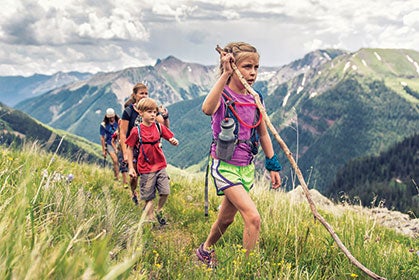
The Redden family in the Colorado high country. Photo by Matt Trappe.
Tennyson Redden begins to run, first with cautious steps, a tip-toed dance over roots and rocks. Then, as the trail plummets steeply into the woods, she turns herself over to gravity. At every switchback, she hollers like a banshee from behind the hood of her rain jacket: “This is so fuuuun!”
Tennyson is 4 years old. I’ve only known her for two days, but from what I can tell, her personality is more angel than banshee. She is a calm, curious child with big brown doe eyes. When she talks, it’s in a breathy whisper.
So when she tears down the trail with high-pitched, delighted shrieks, it’s no wonder her three older siblings, aged 7, 9 and 11, all begin laughing.
“Tenny, slow down!” they yell, chasing after her. “We can’t keep up!”
Tennyson doesn’t seem to hear them. She’s wearing her older sister’s rain jacket, which is several sizes too large, her hands buried inside extra-long sleeves that flap wildly. She keeps running.
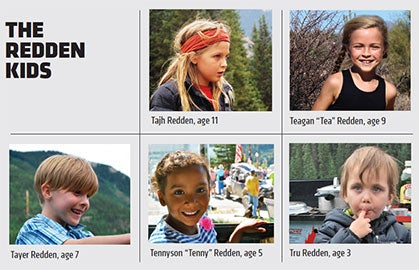
Photos: Yitka Winn; Aravaipa Running.
Few people have heard of Tennyson Redden (yet), who’s since turned 5, but her two oldest siblings, Tajh and Teagan, have made national headlines for completing their first ultramarathons at the ages of 8 and 7, respectively. Both have run multiple 12- and 24-hour races, often racking up 30 to 40 miles at a time. In 2013, at the age of 8, Teagan crossed the finish line at Arizona’s Javelina Jundred 100K in just over 28 hours.
While many people gush with awe and admiration at the kids’ ultrarunning accomplishments, others take to the Internet to express their criticism. Comments have ranged from well-meaning concern for the children’s physical health to vitriolic accusations of child abuse. Most recently, after Teagan’s second Javelina 100K finish in 2014, one woman directed a post on Facebook toward the race directors, Jamil and Nick Coury: “Ultras usually have stringent rules for participating to support health and wellness. Why was a 9-year-old allowed to enter the 100K race?”
Their mom, Sabrina, has little patience for this kind of criticism, which she’s gotten plenty of since her kids started trail running. “I think it’s a very American idea that you shouldn’t be running,” she says. “In plenty of cultures, though, the norm is to travel by foot.”
It’s little surprise that unconventional kids come from unconventional parents: Sabrina and Seth Redden, though now divorced, originally met in high school and got married while skydiving (yes, in the air). They had three kids together before their 25th birthdays, and then adopted two more—Tennyson and Tru—out of the foster-care system. After getting into running in their 20s, Seth and Sabrina dabbled in shorter road races before shifting their focus to the trails and, more recently, the ultra scene.
Even after separating in 2011 and beginning to date other people, they continued living together for a while. They shared what they called their “homeless summer”—several months spent road-tripping in a van across the country with all the kids in tow. Since their official divorce, they share custody of the kids 50/50.
Sabrina has since moved in with Jamil Coury (whom she likes to refer to as her new “+1”), a two-time Hardrock finisher who, under the moniker Aravaipa Running, co-directs many of the races the Redden kids have run. More recently, he founded a company called Run Steep Get High to promote the kind of high-alpine running and outdoor lifestyle that he and Sabrina embrace.
To the concerned Facebook poster after the 2014 Javelina, Coury cited Teagan’s prior ultrarunning experience and the fact that she’d been accompanied by her mom the whole way. The loop format of the course permitted easy exit if a medical issue arose. Allowing kids to run Aravaipa’s ultra-distance races, Coury told me later, is on a case-by-case basis.
“Because I was young [18] when I got into ultras, I can appreciate people doing that,” says Coury, now 29. “I like to be open to [kids running my races], as long as parents are there and supporting it … not yelling at their kids to push harder.”

Sabrina Redden leads her daughter, Tennyson, then 4, on a hike near Silverton, Colorado, with 11-year-old Tajh on the right. Photo by Matt Trappe.
Curious to get to know the personalities of the ultrarunning wunderkinds beyond the sensationalized headlines that have earned them some degree of fame, I asked Sabrina if I could spend a few days with her and her family. If not parental influence, I wondered, what exactly motivates a second grader to push through the physical challenge of an ultramarathon? Was it any different than what motivates an adult to suffer through long, often grueling hours in the woods? Should it be encouraged?
Most of us who run trails or ultras have faced similar questions from well-meaning, but ultimately befuddled, non-runners in our lives: Is that even healthy? Why would you do that? I don’t even like to drive that far!
It remains to be seen, of course, whether the Redden kids’ interest in mountain running will eventually be halted by burnout or injury or otherwise, or whether it will evolve into a lifelong passion. But perhaps the more compelling question to ask is a broader one: with the right approach, and provided the kids themselves are interested, can trail running act as an antidote for many of the challenges facing children in our modern world?
In a society where childhood obesity is on the rise, peer bullying wreaks havoc on self-esteem and unprecedented levels of “screen time” have replaced interactions with the literal world, maybe these kids are on to something profound.
“For a new generation, nature is more abstraction than reality,” Richard Louv wrote in Last Child in the Woods, a 2005 bestseller that explores the crucial role of nature in healthy child—and adult—development. “Increasingly, nature is something to watch, to consume, to wear—to ignore. A recent television ad depicts a four-wheel-drive SUV racing along a breathtakingly beautiful mountain stream—while in the backseat two children watch a movie on a flip-down video screen, oblivious to the landscape and water beyond the windows.”
Most trail runners are well-versed in the magic inherent in covering large swaths of wilderness by foot—the feeling of accomplishment, the camaraderie of belonging to a community, the sense of peace arising from immersion in the natural world. Why shouldn’t that experience be every bit as available, and valuable, to children as it is to adults?
Sabrina readily welcomed my interest in these questions and in her family. She invited me to join her, Jamil and the kids for a long summer weekend in Colorado’s San Juan Mountains. I would be camping, hiking, running and hanging out with kids whose UltraSignup profiles were longer than my own.
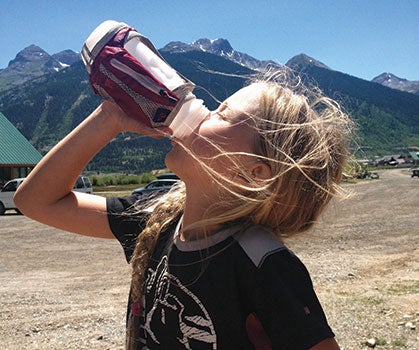
Teagan hydrates after a run. Photo by Sabrina Redden.
Each summer, in anticipation of July 4th and the Hardrock 100-Mile Endurance Run the following weekend, the sleepy town of Silverton, Colorado, comes to life. Its streets—one paved, the rest dirt—are lined with old-timey saloons and ice-cream parlors, set against a backdrop of steep, high-alpine peaks. Thousands of visitors arrive by car or motorcycle or the vintage steam-engine train that chugs into town each afternoon from Durango.
Silverton’s 4th of July celebration is one of the largest in the country, and its schedule of events reads like a day in The Andy Griffith Show’s town of Mayberry: brass-band concert, rhubarb festival, ducky derby, ice-cream social, town picnic and the fire department’s good-natured, massive water fight with hoses on the main drag. The day’s crowning event is the town parade.
For weeks, the surrounding mountains are filled with the pitter-patter of runners’ footfalls as they train on sections of the Hardrock course. Many of the “Hardrockers” have been coming to Silverton since the race’s inception in 1992, and every July is their family reunion.
In other words, Silverton in the summer is a trail-runner’s dream. And the Redden family knows it well: for the past few summers, they’ve road tripped out here from their home base in Phoenix to spend several weeks partaking in the Silverton summer scene.
Tajh, the oldest at 11, has stringy, shoulder-length blond hair that looks as though it’s never met a comb in its life, typically tamed only by a Buff headband. He smiles easily. Of all the kids, Tajh was the first to express an interest in running, asking to accompany his dad on training runs. At age 8, he ran his first ultra, the 2011 Across the Years 24-Hour race, where he completed more than 30 miles.
“When Tajh found out that he could have chocolate and cookies [at the aid stations] if he ran, he said, ‘I’m in! This is the best thing ever!’” says Sabrina. Junk food is a special treat for the kids, who’ve been reared on a vegan diet with few processed foods.
Tajh has what his dad refers to as a “strong internal world”—he loves books and animals, and doesn’t mind spending time alone. When he was asked at school to draw a picture of himself as an old man, the image he conjured was of himself living on a farm, never married, and surrounded by animals he’d rescued.
Nevertheless, he adores the grownup friends he’s cultivated at races. At his first ultra, Tajh met the ultrarunning legend Ray “The K” Krolewicz who, at 59, has racked up more than 500 ultra finishes since completing the inaugural Old Dominion 100 in 1979. Tajh and Krolewicz spent some time running together and, according to Sabrina, “nerding out about books.”
Justin Lutick, 44, another fixture in the trail-running community who knows the Redden kids well, tells me, “I don’t like kids. I don’t have much in common with them; I don’t know about Harry Potter and all that stuff. But these kids are bright and thoughtful. You can carry on a conversation with them on substantive matters. Tajh will roll up and be like, ‘Did you know that a marmot will blah blah blah,’ and I’ll say, ‘No, I didn’t know that! Tell me more.’ And he’ll go off and I’ll learn everything I ever wanted to know about a marmot.”
Teagan, or “Tea,” is 9. She has long blond hair, too, and a radiant, dimpled smile that rarely leaves her face—even during tough spots in her races.
At a 12-hour race in Silverton in 2012 that Tajh was running, Teagan unexpectedly asked for a race bib to run, too. Her parents agreed to let her run on the one-mile loop course as long as she could find someone to accompany her.
Other runners at the race were instantly charmed by the enthusiastic second grader in blond braids. Excitedly hopping at the edge of the course, she tried to flag someone down to run with her. She had no trouble recruiting running buddies and, on virtually no training, knocked out an even 20 miles that day. She was hooked.
Over the past few years, the Redden kids have also grown proficient at crewing at races for their parents or for Jamil, as well as volunteering at aid stations.
“They could run an aid station by themselves,” says Seth. “It’s hilarious. They’re well-known for making these little creations—they’ll grab a saltine cracker, put a date and a gummi worm on it, and stick a toothpick through it. Runners come through, already confused from running for hours, scratch their head and ask, ‘What is that?’ But they love it.”
“Their friends are the ultrarunning community,” Lutick says. “They’re high-fiving and hugging as much I am, because those are their people.” This interest in the social aspect of trail running is especially true of Teagan, whose many “big people friends” routinely come to her defense when strangers lash out on social media.
“Teagan inspired me to finish [Javelina] last year,” wrote one woman, Sandra Vivas, on a recent Facebook thread. “I was injured and falling apart. After seeing her composed, in total control and smiling, it lifted my spirits to make it and get my buckle.”
“I want to be Teagan when I grow up,” wrote another, Trent Collicott.

Teagan and Tajh on a run/hike with their dad, Seth. Photo by Criss Furman.
Though Teagan initially earned her ultrarunning fame alongside Tajh, her brother has since refocused some of his energy on flag football. Teagan, meanwhile, continues to pursue her personal ultrarunning goals with gusto—“She’s super competitive and goal-driven,” says Sabrina.
Tayer, the middle child at age 7, is perhaps the fastest natural runner in the family, but he has little interest in racing. With bright blue eyes and a propensity for stirring up mischief, he is, in Seth’s words, “as typically boy as you can imagine. He’s out playing in the dirt, playing with rocks. If you gave him a slingshot, he’d be shooting everything in sight.”
The youngest two kids, Tennyson, 5, and Tru, 3, came into the world about the same time that the Redden family discovered ultrarunning. Unlike the older kids, they’ve spent the entirety of their childhoods steeped in ultra culture. The games Tenny and Tru play together often revolve around running—strapping their older siblings’ hydration packs to their tiny bodies, announcing they’re going to run Hardrock or Barkley, and tearing off with wild abandon.
Sabrina recently entered the youngest two in a one-kilometer kids’ race in Flagstaff. When someone asked 5-year-old Tennyson later if she’d had fun, she shrugged and said, “It was really short. I was only gone a couple of minutes.”
Tru, at 3, was a different story. He let his mom pin a race bib on him and dutifully lined up next to Tennyson on the starting line—but when the race began and everyone else took off, he just stood still, frowning, and said, “Mommy, no.”
“Basically, it’s my girls who are crazy,” Sabrina says with a laugh. Nevertheless, Tru likes his time in the outdoors, she says. “He’s always talking about the mountains, and he gets really mad when we don’t ‘go to the mountains.’”
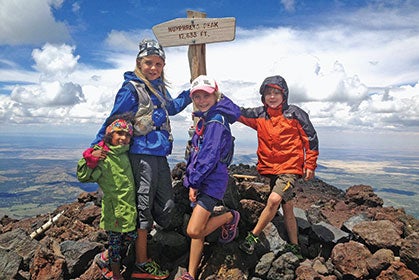
Peakbagging like pros: from left, Tennyson, Tajh, Teagan and Tayer savor the views at the top of Humphreys Peak, the highest point in Arizona at 12,633 feet. Photo by Sabrina Redden.
On my second day in Silverton, Sabrina, Jamil, all five kids, photographer Matt Trappe and I embark on a day hike up to Island Lake, which sits just below Grant-Swamp Pass along the Hardrock 100 course. We hit the trailhead by late morning, the kids saddled with hydration packs and the promise of a Justin’s Nut Butter packet when we reach the lake.
A couple miles into our hike, we stop for a snack break. Sabrina doles out lemon-lime GU gels, another uncommon treat for the kids. Within 20 minutes, they are zig-zagging across the trail like pinballs, grabbing sticks, picking flowers, peering under logs and singing—yelling, really—their favorite songs. Sabrina laughs and says to me, “Well, there’s the sugar! In case you were wondering.”
The kids have alternate names for nearly everything in the mountains. They refer to waterfalls and creeks as “water fountains.” The broad-leaved skunk cabbage so prevalent in the San Juans is “toilet paper.” And when Teagan and Tayer hike up ahead on a mission to find a snowfield, it’s because they want to go “butt skiing.”
I work to keep up with them and soon enough, they find their snowfield—a steep slope that leads directly into a pile of sharp rocks. Giddily, they scurry to the top and sit down on the snow. I bite my tongue and channel my inner Sabrina, remembering a past blog post in which she wrote: “Kids are innately careful … my children climb trees, hang off all the playground equipment, and basically do anything and everything ‘unsafe’ you can think of. I do not say [to them], ‘Be careful,’ and shockingly they usually are careful all on their own.”
Just as the two are about to launch themselves down the snowy slope, Teagan says, “I don’t know if this is a good idea.”
Tayer considers for a moment, then nods. He points to a trickling creek I hadn’t even noticed emerging from beneath the snowfield and says, “Yeah, there might be a snow bridge there. We could fall through.”
So they stand back up and resume hiking on the trail, presumably in pursuit of a safer butt-skiing location.
When we reach the sparkling, turquoise lake, Sabrina promises a puppy to anyone who will swim through its icy waters to its namesake island. She’s joking, of course, but Teagan says sternly, “Mom, that’s crazy. We’d get hypothermia.”
While Sabrina hangs out with the younger kids at the lake, Teagan, Tajh, Jamil and I decide to run-hike up to the 12,920-foot Grant-Swamp Pass, to visit the Joel Zucker Memorial. Zucker, an avid ultrarunner, died unexpectedly of a cerebral hemorrhage in 1998, two days after completing his third Hardrock Hundred. He was 44 years old. Tradition calls, Jamil tells us, for placing a rock at the foot of the memorial’s commemorative plaque.
The trail to the top is serious business. It’s eroded away significantly in places, giving way to steep scree fields. A Hardrock veteran I’d met in town had suffered a bad fall earlier that week while training on this section. He’d sprained his wrist. We pass a hiker who’s nervously picking her way down, cursing under her breath.
The kids are calm and meticulous in making their way to the top, soliciting Jamil’s advice on foot placement and where to go when the trail braids into stretches of slippery, loose dirt. Arriving at the pass, we peer over the other side into the majestic Swamp Canyon, filled with snow and framed with craggy peaks stretching toward the sky. The wind whips our faces.
We don’t say much, but quietly take turns placing our rocks at the foot of the memorial. Engraved on it is a quote from the German philosopher Goethe: “Whatever you think you can do or believe you can do, begin it. Action has magic, grace and power in it.”
On our way down, Teagan talks about her next running goals—Javelina 100K again later that year, maybe a Hardrock qualifier the following year.
“In the day-to-day, everything’s busy and we’re constantly going, going, going,” Sabrina tells me later. “[The kids] aren’t super kind to each other in the house; they fight, they have issues. But the moment we get on the trails, they’re all playing the same game and having these discussions that they don’t normally have. It’s such a clear world.”
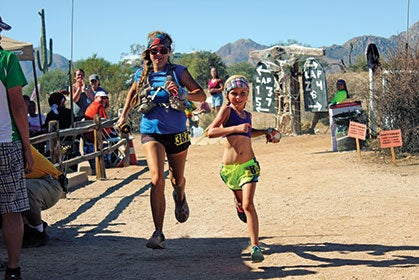
Teagan, then 8, and her mom, Sabrina, sprint the final stretch of the 2013 Javelina Jundred 100k. Photo by Aravaipa Running.
No studies have ever been done on the long-term effects of distance running on children’s developing bodies. A 2007 article in Pediatrics by Joel S. Brenner, MD, concluded, “There is, at present, no scientific evidence that supports or refutes the safety of children who participate in marathons. … Ultimately, there is no reason to disallow participation of a young athlete in a properly run marathon as long as the athlete enjoys the activity and is asymptomatic.”
Nevertheless, Sabrina and Seth have been extremely careful along the way. They’ve incorporated precautions like serving as or recruiting adult running buddies for the kids, sticking to short-multiple-loop race courses, dropping out of races as needed and avoiding even the short-term levels of sleep deprivation that ultrarunners tend to accrue during races. Teagan slept for six hours in the middle of her first 100K.
“I think that if anyone’s concerned about long-term safety, they probably should not let their kids play any sports,” says Sabrina.
Indeed, the only injuries the kids have sustained have come from elsewhere in their lives. Recently, Tayer broke his arm playing soccer. According to Sabrina, at every physical exam the children have had with their doctors, including blood work tests, their health has checked out perfectly.
Yet the debates continue to rage in cyberspace. In a thread that surfaced on Facebook shortly after Teagan completed her first 100K, one poster wrote, “Am I the only one who thinks this may be slightly excessive? Running is an overuse sport, right?” Another added: “I’m concerned as well,” followed by a third poster: “Totally agree … This is a huge mistake as far as development goes. It is an amazing feat but at what expense. Mark my word, she keeps this up she will have issues.”
Because there is no research on the subject, the only arguments on either side are inherently anecdotal ones. The Redden kids, though, are hardly the first ones to experiment with running long distances.
In response to the above comments, a 57-year-old runner named David Campbell chimed in to say he’d run his first marathon at 14 and was told for years how much damage he was doing to himself by running at that age. He’s since run hundreds of marathons and ultras and is still going strong today.
“I started running marathons back in the days when women weren’t allowed because it was damaging to their health,” Campbell wrote. “Paper after paper was written by doctors on the extensive damage that women would suffer if they tried distance running. … It’s kind of funny looking back on it now, but in the decades since then I don’t know a single woman who [while running] had her uterus fall out.”
Additionally, he wrote, “Based on a lifetime of running and having watched both these kids in action, the only mistake that I could see is for anyone to limit or hold back these kids from doing what they love.”
As for the accusations that the Redden kids are pressured into performing, those who know the family well are quick to defend them. Julie Hooks of Sisters, Oregon, first met the Redden family two summers ago in Silverton. Though her own teenaged son, TJ, is an avid ultrarunner, Hooks admits that before she met the Reddens, even she had her reservations: “I kept hearing about this crazy family, with sticks in their hair and running ultras, and my first kneejerk reaction was that I was livid. I thought, ‘Here is another family trying to push their kids.’ But then I met them and saw that no, these kids just love to have fun. I’ve seen them on the tops of 14ers, and they’re happy.”
Since then, Hooks’ 12-year-old daughter, Vickie, an avid horseback rider, has become good friends with Teagan. Teagan has since taken up horseback-riding lessons, while Vickie has dabbled in trail running.
“When people accuse me of pressuring my kids to run ultras,” says Sabrina, “I’m like, have you ever been to one of these races? No one can be pushed into doing an ultra. You have to really, really want to do it, for yourself.”
At the 2013 SOB 50K in Oregon, Teagan had set a goal of finishing it in less than 7.5 hours. As she tired toward the end, her dad reminded her it was OK to slow down. But Teagan refused. Committed to her personal goal, she dug deep, blew through the final aid station and crossed the finish line in 7:22.
During a recent phone interview, Seth lit up when he recalled watching his daughter finish that race: “You could just see in her face that she totally understood how valuable that was, that she had run every one of those steps in that amount of time and no one else had done it for her. All the training she put in, every step she took—that’s hers.”
From what I observed in my three days with the Redden kids in the San Juans, they love running on trails for many of the same reasons that the rest of us do—the challenge of it, the friendships forged, the sense of both peace and adventure that comes from exploring the outdoors. They have wilderness experience and knowledge that rivals that of most adults I know.
On another recent social-media thread about the Redden kids, Jimmy Dean Freeman, an avid ultrarunner and endurance coach, wrote this: “Someday, I’m hoping to create a clinic or retreat that engages both Colby Wentlandt [another young runner, now 15, who finished his first 100-miler at age 12] and Teagan Redden so they can share their secrets of mental tenacity, as I’ve never seen either of these amazing athletes flagging. And yet I’ve seen hundreds of other kids at airports and in restaurants in full-scale meltdown mode because the power ran out on their iPad or Playstation Vita.”
Back on the trail, on our way down from Island Lake, Tennyson is picking up speed as she runs.
“She’s never really done this before,” Sabrina tells me. We run, too, to keep up.
And then, suddenly, Tennyson trips. Her bright pink Velcro shoes go out from under her as her tiny body pitches forward, landing face-first in the rock-strewn trail. For a moment, she doesn’t move or make a sound.
“Tenny!” Tajh cries out. “Are you OK?”
Slowly, she rolls over in the dirt. As she does so, her face emerges from the cavern of her hood. Spread across it is a wide, toothy smile.
“I fell!” she announces, giggling. “I slipped in the mud.”
Not bothering to wipe the dirt off her leggings, she stands back up and, like any good trail runner, begins to run again.
This article originally appeared in our January 2015 issue.
